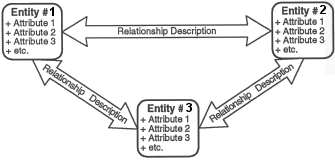Concept Mapping: The Preferred Choice
Hitherto an area of interest only to Cognitive Science, Artificial Intelligence and Educational Technology, 'concept mapping' is now considered by researchers and educationalists to be an excellent way of capturing a knowledge area. It is becoming increasingly popular and is used, for example, by systems analysts to obtain an understanding of systems planned for automating or upgrading. The approach forces discovery of basic conceptual units and their relationships, typically in a brain-storming wall-board session.
Concept maps are graphic displays of knowledge topics in a node-link structure. The nodes represent concepts, entities or things that are described by labels with a set of attributes. The links show both the connections between appropriate nodes and describe the nature of each relationship, as shown in the Simple Concept Map, Exhibit 1. Since the most important single factor influencing learning is what the learner already knows, concept mapping provides a way for people to consciously and explicitly tie new knowledge to relevant knowledge they already possess. A big advantage of the Concept Map is that it provides a visual image of the components and their relationships so that it can be studied very easily.
Steps to constructing a concept map involve:
- Select: Focus on a theme and then identify related key words or phrases as labels
- Rank: Rank the labels from the most abstract and inclusive to the most concrete and specific
- Cluster: Cluster labels that function at similar levels of abstraction and those that interrelate closely
- Arrange: Arrange labels into a diagrammatic representation
- Attribute: Add attributes to each label if/as appropriate
- Link and describe relationship: Connect the labels with linking lines and name each link-line with a relationship description.

Exhibit 1: Simple Concept Map
The labels selected may in fact be concepts, ideas, entities or things. Their attributes are often simply sub-category labels. Typical relationships include one or more of the following: Has part(s): Implements; Has Goal(s); Uses; Satisfies; Has Output(s); Has Example(s); or Relates to (undefined generic relationship). A subtlety of the approach is that any attribute or relationship might be converted into an entity if its content is to be further elaborated, or vice versa. Concept maps can get very complicated depending on the number, type and level of detail of the relationships exposed.
However, graphical software is now available that greatly facilitates electronic concept mapping. One example is SemNet, short for Semantic Networks, presently under development.[10] This innovative software for the Mac works like a word processor, but can be used to portray any descriptive domain of knowledge. SemNet is a hypertext environment in which ideas and concepts on any subject can be organized into a network of descriptors linked by named relationships. The nets can be elaborated with objects like charts, pictures, sounds, multimedia and web documents, and can even be merged together.
One of many other software products for the PC-Windows environment and serving similar purposes is Visio[11]. Visio uses the metaphor of drafting templates from amongst several of which appropriate symbols can be 'drag and dropped' anywhere on a past-up board. Its power is in the automatic attached arrow links that can be created as relationships, complete with descriptive text automatically displayed in the shaft of the arrow.
So now we have the tools available, but even so, the 'maps' thus developed, represent only the view of the knowledge area according to the perspective selected.
Believe it or not, it turns out that representation of the concept map found most useful for teaching and learning is one with which project management people are most familiar. That is, a typical 'organization chart' that has the more general and inclusive concepts at the top and the more detailed ones at the bottom. However, the boxes need elaborating with their attributes and the links must be annotated to show the specific relationships.
For purposes of hardcopy distribution or keyword searches, this chart can be reduced to an 'outline form' by:
- Tabbing in for each level of label (as is usual)
- Adding the relationship description in brackets to the end of each label for both 'peer' and 'child' relationships
- Repeating the label if it has a cross-reference relationship, i.e. a relationship to another part of the structure (in lieu of a 'hypertext' link)
- Including any attributes of the label in the next lower level of the hierarchy, generally when it forms the lowest level of that particular branch.
So now we have the principles of our PMKS, and the labels are the PMKDs.
10. SemNet Research Group, San Diego State
University, 1991
11. Visio Corporation (1990), http://www.visio.com
|



